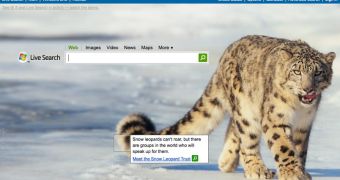Apple has long accused Microsoft openly that it is copying its Mac OS X operating system with Windows releases. The Redmond company countered on the same note, indicating that there are features on OS X inspired by Windows. In this escalating face-off, Microsoft managed a new move over its rival in Cupertino. It paraded its own breed of “snow leopard,” this time the real thing, not just the codename for the next version of Apple's operating system. As you can see from the image on the left, Microsoft featured a snow leopard as a background for its search engine, Live Search.
At the end of July 2008, Microsoft introduced an overhaul to the Live Search home page, which from that point on started featuring a background image. The Redmond company was playing around with discoverability, indicating that the search users experienced could be much more than just a field for queries and a collection of links. In this context, the software giant aimed to share its own searches with the world through links embedded in the background images.
This is precisely the case for Live Search's snow leopard. One of the hidden links, which becomes visible on a mouse hover event, reveals the following text: “Snow leopards can't roar, but there are groups in the world who will speak for them.” Whether the remark was indeed directed at Apple and Apple's fanboys, or it was simply a way to introduce the Snow Leopard Trust is up for speculation and debate. In case you were oblivious to the detail, the snow leopard is also the symbol used by the Girl Scouts of Kyrgyzstan, perhaps another wink at Apple, perhaps not...
Just as Microsoft is building Windows 7, Apple is also developing the next iteration of its Mac OS X operating system, codenamed snow leopard. In contrast, Microsoft was less creative with the codename this time around, as Windows 7 was codenamed Windows 7. With the release of the Beta version of Windows 7, there have been fingers pointed at Microsoft, yet again, and accusations that it is copying OS X, especially because of the similarities between the Superbar (the evolved Windows Taskbar) and OS X's Dock.

 14 DAY TRIAL //
14 DAY TRIAL //